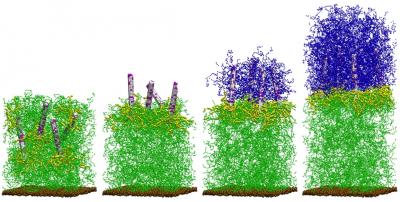Nov 27 2013
When a chair leg breaks or a cell phone shatters, either must be repaired or replaced. But what if these materials could be programmed to regenerate-themselves, replenishing the damaged or missing components, and thereby extend their lifetime and reduce the need for costly repairs?
 This is a self-generating composite image. Credit: University of Pittsburgh
This is a self-generating composite image. Credit: University of Pittsburgh
That potential is now possible according to researchers at the University of Pittsburgh Swanson School of Engineering, who have developed computational models to design a new polymer gel that would enable complex materials to regenerate themselves. The article, "Harnessing Interfacially-Active Nanorods to Regenerate Severed Polymer Gels" (DOI: 10.1021/nl403855k), was published November 19 in the American Chemical Society journal Nano Letters.
Principal investigator is Anna C. Balazs, PhD, the Swanson School's Distinguished Robert v. d. Luft Professor of chemical and petroleum engineering, and co-authors are Xin Yong, PhD, postdoctoral associate, who is the article's lead author; Olga Kuksenok, PhD, research associate professor; and Krzysztof Matyjaszewski, PhD, J.C. Warner University Professor of Natural Sciences, department of chemistry at Carnegie Mellon University.
"This is one of the holy grails of materials science," noted Dr. Balazs. "While others have developed materials that can mend small defects, there is no published research regarding systems that can regenerate bulk sections of a severed material. This has a tremendous impact on sustainability because you could potentially extend the lifetime of a material by giving it the ability to regrow when damaged."
The research team was inspired by biological processes in species such as amphibians, which can regenerate severed limbs. This type of tissue regeneration is guided by three critical instruction sets – initiation, propagation, and termination – which Dr. Balazs describes as a "beautiful dynamic cascade" of biological events.
"When we looked at the biological processes behind tissue regeneration in amphibians, we considered how we would replicate that dynamic cascade within a synthetic material," Dr. Balazs said. "We needed to develop a system that first would sense the removal of material and initiate regrowth, then propagate that growth until the material reached the desired size and then, self-terminate the process."
"Our biggest challenge was to address the transport issue within a synthetic material," Dr. Balazs said. "Biological organisms have circulatory systems to achieve mass transport of materials like blood cells, nutrients and genetic material. Synthetic materials don't inherently possess such a system, so we needed something that acted like a sensor to initiate and control the process."
The team developed a hybrid material of nanorods embedded in a polymer gel, which is surrounded by a solution containing monomers and cross-linkers (molecules that link one polymer chain to another) in order to replicate the dynamic cascade. When part of the gel is severed, the nanorods near the cut act as sensors and migrate to the new interface. The functionalized chains or "skirts" on one end of these nanorods keeps them localized at the interface and the sites (or "initiators") along the rod's surface trigger a polymerization reaction with the monomer and cross-linkers in the outer solution. Drs. Yong and Kuksenok developed the computational models, and thereby established guidelines to control the process so that the new gel behaves and appears like the gel it replaced, and to terminate the reaction so that the material would not grow out of control.
Drs. Balazs, Kuksenok and Yong also credit Krzysztof Matyjaszewski, who contributed toward the understanding of the chemistry behind the polymerization process. "Our collaboration with Prof. Matyjaszewski was exceptionally valuable in allowing us to accurately account for all the complex chemical reactions involved in the regeneration processes" said Dr. Kuksenok.
"The most beautiful yet challenging part was designing the nanorods to serve multiple roles," Dr. Yong said. "In effect, they provide the perfect vehicle to trigger a synthetic dynamic cascade." The nanorods are approximately ten nanometers in thickness, about 10,000 times smaller than the diameter of a human hair.
In the future, the researchers plan to improve the process and strengthen the bonds between the old and newly formed gels, and for this they were inspired by another nature metaphor, the giant sequoia tree. "One sequoia tree will have a shallow root system, but when they grow in numbers, the root systems intertwine to provide support and contribute to their tremendous growth," Dr. Balazs explains. Similarly, the skirts on the nanorods can provide additional strength to the regenerated material.
The next generation of research would further optimize the process to grow multiple layers, creating more complex materials with multiple functions.
Press release avilable from http://www.eurekalert.org/